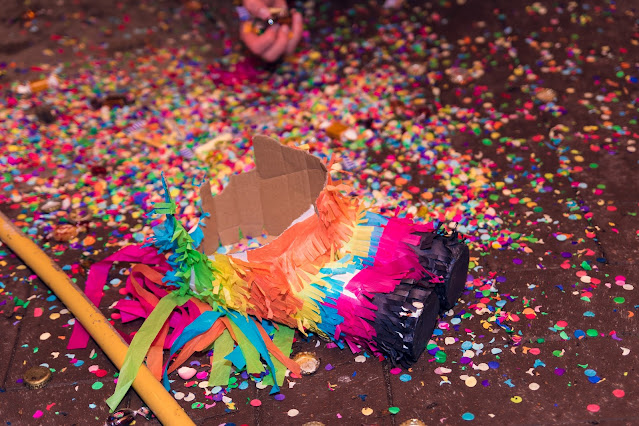 |
| Piñata |
In Tenerife, the last weekend of carnival and first weekend of Lent, is known as Piñata Weekend when supposedly pre-Lenten carnival festivities continue.
Piñatas are a central element of birthdays and other festive celebration events. Children try to break them to enjoy the loot of candies and other gifts that are hidden inside. However, its origin is not related to children's entertainment.
The piñata is associated with Latin culture, although historians point to Asia (particularly China) as its actual point of origin. The famous traveller Marco Polo, on his visit to that nation, is supposed to have seen how the Chinese created colourful figures of animals covered with paper, which were hung and used in New Year celebrations. Polo brought the idea of those first piñatas to Europe.
Europeans linked the piñata with the celebrations of Lent. The first Sunday of that liturgical period became "Piñata Sunday", derived from the Italian term pignatta, whose meaning in Spanish is "fragile pot". The custom spread to nearby regions, where Lent acquired the celebration of "El Baile de la Piñata" (Piñata Ball), in which a clay vessel known as "la olla" was used to serve as a piñata.
Rumours of such a tradition crossed the ocean and reached America. The Spanish missionaries took their piñatas with them, covering them with coloured paper, with the aim of attracting parishioners to their religious ceremonies.
Eventually, the piñata acquired religious significance, as it was intended to represent Satan, who was credited with wearing attractive masks to induce people to become sinners. The piñata then took on a satellite shape: a sphere with seven protruding cones. These cones represented the seven deadly sins: greed, gluttony, sloth, pride, envy, anger, and lust. The candies inside were symbols of the temptations that wealth and earthly pleasures implied.
The custom of breaking the piñata arose in Mexico. Blindfolded participants were ordered to hit the piñata in an effort to combat demonic forces. The club used to smash the piñata, symbolized virtue. Once the piñata was broken, its content was the prize to the participants for being faithful to their faith.
Slowly, the piñata lost its religious association, and today it is merely considered a symbol of fun and entertainment, although it retains its religious significance in some regions. It can be used during the holiday season or at birthday parties, and is no longer reserved for the Latino culture, as people of all nationalities and backgrounds take turns hitting the piñata.
The Baile de la Piñata (Piñata Ball) continues to be celebrated in Tenerife as the central event to the carnival festivities in the remote hamlet of Teno Alto.





 After more than 20 years, posts here will now only be occasional (
After more than 20 years, posts here will now only be occasional (